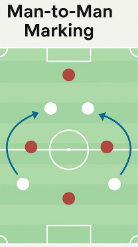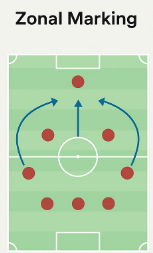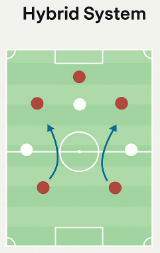Zonal Vs Man Marking
Understanding Defensive Tactics in Football
Yusuf
In football, teams typically use zonal marking or man-to-man marking (also called man marking) to stop attackers. It's like the difference between guarding a space vs. shadowing a player. Each approach has pros and cons depending on the opponent. In this article, we’ll break down each system—with examples from top teams—and see when coaches choose one over the other. Imagine a corner kick setup: in a man-marking system, each defender shadows a particular attacker, whereas in a zonal system each defender covers a designated zone of the box. In open play, it’s similar: in man marking, defenders tightly follow attackers (1v1 duels) wherever they go. In contrast, zonal marking means defenders form a compact block and guard spaces, not people. For example, Pep Guardiola’s teams (like Manchester City) usually organize zonally, with players covering space intelligently rather than chasing every runner. The advantage is that the defensive shape stays compact, making it harder for opponents to break through gaps.
How Zonal Marking Works
Zonal marking emphasizes defensive structure. Each player has a “zone” and moves with the ball, sliding left or right as needed. In this system, defenders focus on staying tight together. For instance, when City drops into defense, you’ll see their back four shifts as a block, leaving no free lane for attackers. Zonal defending excels against possession-heavy teams that try to switch play and overload sides. The defenders don’t follow every run; instead, they guard lanes and passing channels. This way, attacks can be delayed and frustrated by the line of defenders. As one analysis notes, zonal marking keeps a “solid base” to launch counterattacks once possession is won.
When to Use Man to Man Marking
Man-marking is the traditional approach: each defender has a particular opponent to lock onto. It’s especially useful when there’s one key playmaker or striker to worry about. It is common to use man marking when you want to “disrupt individual threats”. For example, Marcelo Bielsa’s Leeds United famously used this system in open play, assigning defenders to opponents throughout the match. This can frustrate creative players by putting constant pressure on them. Man marking also fits aggressive, high-press teams who want to suffocate opponents immediately. However, it can drag defenders out of position and create gaps if an attacker beats his marker. It demands peak concentration and communication—one slip-up and a free player may emerge.
The Hybrid System
No system is perfect. Man marking can limit an attacker’s freedom and force errors, but it risks defenders being dragged out of position and leaving space. Zonal marking keeps a compact shape and reduces confusion on overlaps, yet if communication breaks down it can give skilled opponents too much freedom. That’s why many teams today blend the two: use zonal structure with key men stepping out to mark. In fact, modern set-piece strategies often mix methods. A common hybrid is to put big defenders in zones (e.g., posts or box zones) while assigning agile defenders to mark the tallest threats.






Pep vs Bielsa vs Simeone
Pep Guardiola’s Manchester City – Zonal Specialists.
Guardiola’s teams are known for their structured zonal defense. They rarely handcuff defenders to one man; instead, players cover spaces and shift as a unit. City’s defenders trust each other to cover any loose runners, so nobody chases far from the line. The result is that there are very few gaps to exploit. In fact, an analysis of Premier League corners noted that City (using zonal setups) conceded just 3 goals from 129 corners, far better than teams relying on man-marking.
Marcelo Bielsa’s Leeds United – Pure Man Marking.
Under Bielsa, Leeds became known for one of the most aggressive man-marking systems in modern football. They followed opponents relentlessly all over the field. This could be maddening for attackers but risky if any marker is outpaced. As one site noted, Leeds was the only team in 2021–22 to regularly use man marking in open play, highlighting how rare it’s become.
Diego Simeone’s Atlético Madrid – Hybrid & Man-Focused.
Simeone’s Atlético blends both approaches. Typically, the back four is zonal and compact, but his midfielders (and even strikers) apply tight man marking in central areas. This hybrid style forces play wide and clogs central channels. In other words, Simeone’s side screens passes zonally but sends a man to shadow dangerous opponents. It’s a middle path—almost like having a zonal block with extra trackers for top scorers. Simeone’s setup is legendary in Spanish football for its discipline and intensity. In the end, defending is about discipline and awareness, not just the system name. The choice between zonal and man marking depends on your squad and opponent. The truth is that the best teams nowadays use a bit of both. Knowing when to zone up or go individual can make the difference between conceding or keeping a clean sheet. There’s no absolute “right” or “wrong”—it’s all about using the right tool at the right moment.
Connect
Stay updated with our latest insights.
Contact
theplaybooksportinfo@gmail.com
9999038304
© 2025. All rights reserved.
